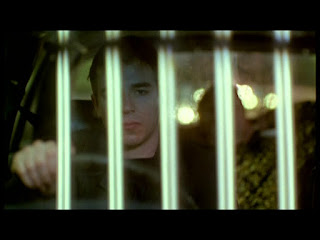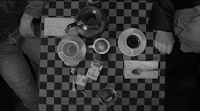In 'Se7en', directed by David Fincher, there is emphasis on the establishing of character. Figure 1 displays a range of props which present aspects of the character of Detective Somerset (the protagonist of the film). This is a high-angle close-up which emphasises the importance of the props, both to the character and to the audience as they form their initial impression of him. The police badge signifies that the protagonist is a detective (a conventional character of the genre). The pocket-knife and gun create connotations of danger and foreshadow the themes of violence within the plot. They could also present Somerset as cautious because he is prepared to defend himself, plus having the gun carefully stored in a case may suggest that he is restrained. The ambiguous prop of the floral wallpaper creates juxtaposition with these two weapons, possibly signifying a more sensitive and sentimental side to Somerset. Additionally, the prop of the pen may present him as intellectual. Furthermore, the neat arrangement of the character's belongings present him as organised.
In Figure 2, Somerset is foregrounded by shallow focus.This emphasises the distance between him and the other characters in the scene, creating a sense of isolation and possibly presenting him as lonely. This intense focus could also present his concentration and dedication to his job. Somerset speaks his first line of dialogue in the film during this scene; in response to being told that the murder was a "crime of passion", he says "Yeah, just look at all the passion on that wall." This sarcastic remark presents him as cynical.
Tone/mood
The opening of 'The Disappearance of Alice Creed', which was directed by J Blakeson, heavily focuses on establishing tone. The film begins with a constantly moving camera, which seems ominous and creates a sense of threat as well as building tension. The washed-out colour palette and mundane location (an airport car park) in figure 3 creates connotations of bleakness. Additionally, the shallow focus presents the anxiety of the foregrounded character so creates a sense of apprehension and suspicion.
Shallow focus is used in further shots in 'The Disappearance of Alice Creed' to reinforce this tense tone. The extreme close up in figure 4 creates a sense of intensity, plus the prop of the power tool is mildly threatening which is reinforced by its harsh diegetic sound.
Tone is also established in the opening of 'Layer Cake', directed by Matthew Vaughn; the protagonist and his lifestyle are presented as 'cool' and enviable. This is conveyed by the camera's constant movement and smooth transitions (including wipe transitions and match cuts), which convey ease and control. The cold colour palette in figure 5 suggests sophistication and the symmetry of the shot reinforces a sense of calm and order. This is emphasised by the deep depth of field which, opposite to the shallow depth of field in 'The Disappearance of Alice Creed', suggests clarity and that the protagonist is assured. Slow-paced non-diegetic music reinforces the sense of relaxed and 'cool' tone.
Themes
Conventional themes of film noir are established in the opening of 'Double Indemnity', which was directed by Billy Wilder. In figure 6, the character's fedora hat (part of the classic costume of a male protagonist in film noir) obscures his face, presenting him as an enigma and conveying the theme of suspicion. Additionally, the conventional dark shadows in the shot connote immorality, presenting the theme of corruption. The imbalance in figure 6 (with the protagonist confined to one side of the shot) suggests a feeling of claustrophobia which could present the theme of fate, foreshadowing that the protagonist becomes trapped by his scheme.
Figure 7 (a shot from 'Essex Boys', directed by Terry Winsor) presents the theme of hopelessness due to its washed-out colour palette which connotes bleakness and misery. The path in this scene has an off-center vanishing point, creating a sense of disorientation which suggests uncertainty and may also signify that the characters feel aimless, presenting the theme of desperation. This extreme long shot presents a barren location, suggesting vulnerability because the character appears isolated within the wide expanse.
 |
| Figure 2 |
 |
| Figure 3 |
Tone/mood
The opening of 'The Disappearance of Alice Creed', which was directed by J Blakeson, heavily focuses on establishing tone. The film begins with a constantly moving camera, which seems ominous and creates a sense of threat as well as building tension. The washed-out colour palette and mundane location (an airport car park) in figure 3 creates connotations of bleakness. Additionally, the shallow focus presents the anxiety of the foregrounded character so creates a sense of apprehension and suspicion.
 |
| Figure 4 |
 |
| Figure 5 |
 |
| Figure 6 |
Conventional themes of film noir are established in the opening of 'Double Indemnity', which was directed by Billy Wilder. In figure 6, the character's fedora hat (part of the classic costume of a male protagonist in film noir) obscures his face, presenting him as an enigma and conveying the theme of suspicion. Additionally, the conventional dark shadows in the shot connote immorality, presenting the theme of corruption. The imbalance in figure 6 (with the protagonist confined to one side of the shot) suggests a feeling of claustrophobia which could present the theme of fate, foreshadowing that the protagonist becomes trapped by his scheme.
 |
| Figure 7 |














